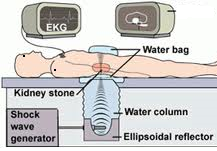How Lithotripsy Works In Kidney Stone Treatment?
Extracorporeal shock wave lithotripsy (ESWL) is a non invasive procedure (where no incision or sutures are required), for treatment of kidney stones and gall bladder stones. The use of lithotripsy is increasing and it is estimated that in the United States alone more than a million patients are treated every year using lithotripsy.
Lithotriptor is the machine which generates shock wave high-intensity acoustic pulse, which is responsible for breaking of the stones into smaller pieces, which can be easily passed out via urine. More than one sitting is generally required for treating a patient with kidney stone.

Lithotriptor is designed to break the stones minimal collateral damage and used from outside. The patient to be treated with lithotripsy is sedated or anesthetized and allowed to lie down in the apparatus’ bed. The back of the patient is supported by a water-filled coupling device placed at the level kidneys. To find the exact location of kidney stones and to aim the high-intensity acoustic pulse, ultrasound imaging or fluoroscopic X-ray imaging is used.
The second and late generation lithotripsy machines use an acoustic lens to focus the shock wave directly at the stone(s). The acoustic lens works like an optical lens and help in focusing the shock wave exactly at the desired loci, i.e. stone. The frequency of acoustic pulse is kept low (to minimize collateral damage and morbidity) and the power level gradually increased, to break up the stone. The final power level depends on the observed success of stone breakage as well as the pain threshold of the patient. Sedating or anesthetizing a patient can help increasing the power levels to be brought up more quickly and a much higher pulse frequency, although it may increase risk of morbidity and collateral damage.
Shock waves are delivered in succession, which increase the pressure that becomes shearing force to break the stone into smaller pieces. The smaller pieces of the stone are than able to pass through ureters or cystic duct in case of gall bladder stone. Lithotripsy works best if stones are between 4 mm to 2 centimeters in diameter.
If a stone is positioned near a bone, it may be uncomfortable for patient during the procedure and resonance felt by the patient.
DISCLAIMER: THE STORY(s) DEPICTED ON THIS SITE AND THE PERSON(s) DEPICTED IN THE STORY ARE NOT REAL. RATHER, THIS FICTIONAL STORY IS BASED ON THE RESULTS THAT SOME PEOPLE WHO HAVE USED THESE PRODUCTS HAVE ACHIEVED. THE RESULTS PORTRAYED IN THE STORY AND IN THE COMMENTS ARE ILLUSTRATIVE, AND MAY NOT BE THE RESULTS THAT YOU ACHIEVE WITH THESE PRODUCTS. THIS PAGE RECEIVES COMPENSATION FOR CLICKS ON OR PURCHASE OF PRODUCTS FEATURED ON THIS SITE.



0 Response to "How Lithotripsy Works In Kidney Stone Treatment?"
Post a Comment